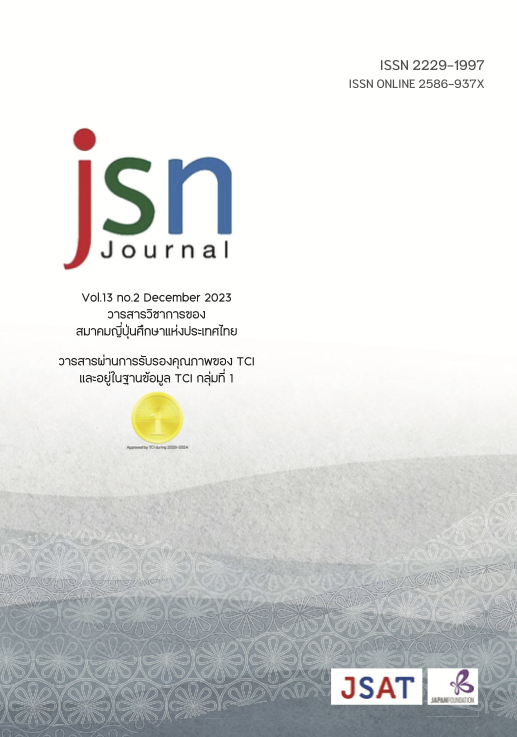A Study of Methods for Memorizing and Reading Hiragana Letters Through the Self-Assessment of Beginning Japanese Learners
Main Article Content
Abstract
This study aimed to explore differences in Hiragana letter memorizing methods and Hiragana reading. There were 154 participants, who were 3rd-year students enrolled in JPN-301 Business Japanese 5 at the Thai-Nichi Institute of Technology. A questionnaire was used as the research instrument. The statistics used for analyzing the data were mean, standard deviation, and t-test. The participants were divided into two groups; the students in the first group had higher Hiragana reading test scores compared to the score average, while the second group had lower Hiragana reading test scores compared to the average. The findings illustrate the different techniques applied among the two groups. In terms of the memorizing method, listening to the sounds was not paid attention to by the second group as much as other methods; and in terms of the Hiragana reading, in the first group, the reading score and student self-assessment were congruent with their actual ability. Conversely, the second group score was not congruent with their actual ability.
Article Details

This work is licensed under a Creative Commons Attribution-NonCommercial-NoDerivatives 4.0 International License.
ข้อความและข้อคิดเห็นต่างๆ ในบทความเป็นของผู้เขียนบทความนั้นๆ ไม่ใช่ความเห็นของกองบรรณาธิการหรือของวารสาร jsn Journal
References
Coltheart, M., Rastle, K., Perry, C., Langdon, R., & Ziegler, J. (2001). DRC: A dual route cascaded model of visual word recognition and reading aloud. Psychological Review, 108 (1), 204-256. https://doi.org/10.1037/0033-295X.108.1.204
Council of Europe. (2001). Common European Framework of Reference for Languages: Learning, Teaching, Assessment. Cambridge, UK: Cambridge University Press.
Seidenberg, M.S., & McClelland, J.L. (1989). A distributed, developmental model of word recognition and naming. Psychological Review, 96 (4), 523-568. https://doi.org/10.1037/0033-295X.96.4.523
浅田和泉 (2006). 「簡体字および繁体字使用者におけるひらがな導入方法別学習効果」『熊本大学言語学論集ありあけ』5, 121-158.
粟田のり子・池田誠喜 (2020).「小学校低学年の読みのアセスメントと指導」『鳴門教育大学大学校教育研究紀要』34, 55-63. http://doi.org/10.24727/00028518
池田伸子(2015).「ディスレクシアを抱える日本語学習者に対する読み学習支援に関する一考察」『日本語教育実践研究』2, 1-15. http://doi.org/10.14992/00011260
伊藤秀明 (2019).「読字能力の評価尺度の再考―「基礎段階の言語使用者」に注目してー」『基礎教育保障学研究』3, 72-86. https://doi.org/10.32281/jasbel.3.0_72
梅田康子・水田澄子・鈴木庸子(2009).「韓国人高校生のためのIS連想法ひらがな学習カードの評価ー記憶方略およびARCS動機付けモデルの観点からー」『言語と文化:愛知大学言語教育研究室紀要』47 (20), 121-139.
三盃亜美・Max Coltheart・宇野彰・春原則子(2014).「発達性読み書き障害成人例と仮名文字列音読における語彙処理と非語彙処理の発達的問題ー文字長と語彙性効果を指標にしてー」『音声言語医学』55 (1), 8-16. https://doi.org/10.5112/jjlp.55.8
清水裕士(2016).「フリーの統計分析ソフトHAD:機能の紹介と統計学習・教育,研究実践における利用方法の提案」『メディア・情報・コミュニケーション研究』1, 59-73.
仲真紀子 (1997).「記憶の方法:書くとよく覚えられるのか?」『遺伝』51 (1), 25-29.
中村典生 (2005).「小学校英語における文字導入の問題点」『岐阜市立女子短期大学研究紀要』55,
-22. http://doi.org/10.24516/00000317
林真理佳 (2019).「読みに困難のある児童に対するアセスメントーつまずきの状態を把握して指導に繋 げる読みの「原因チェックテスト」の開発ー」『明星大学発達支援研究センター紀要』4, 65- 76.
樋渡康敬・橋本洋輔 (2018).「学期当初にひらがな習得が困難だった学生の一学期間の学習状況」『日本語教育方法研究会誌』24 (2), 88-89. https://doi.org/10.19022/jlem.24.2_88


